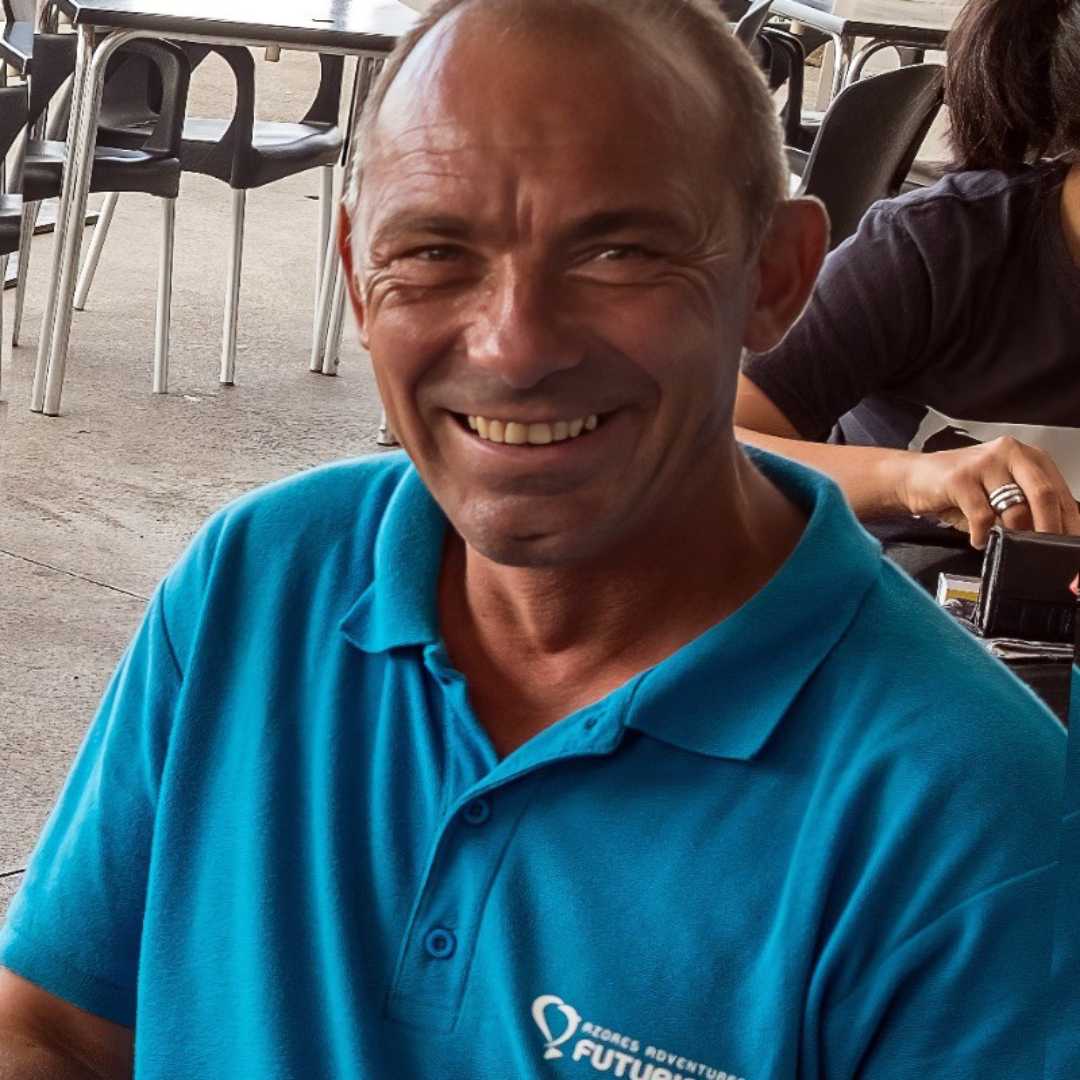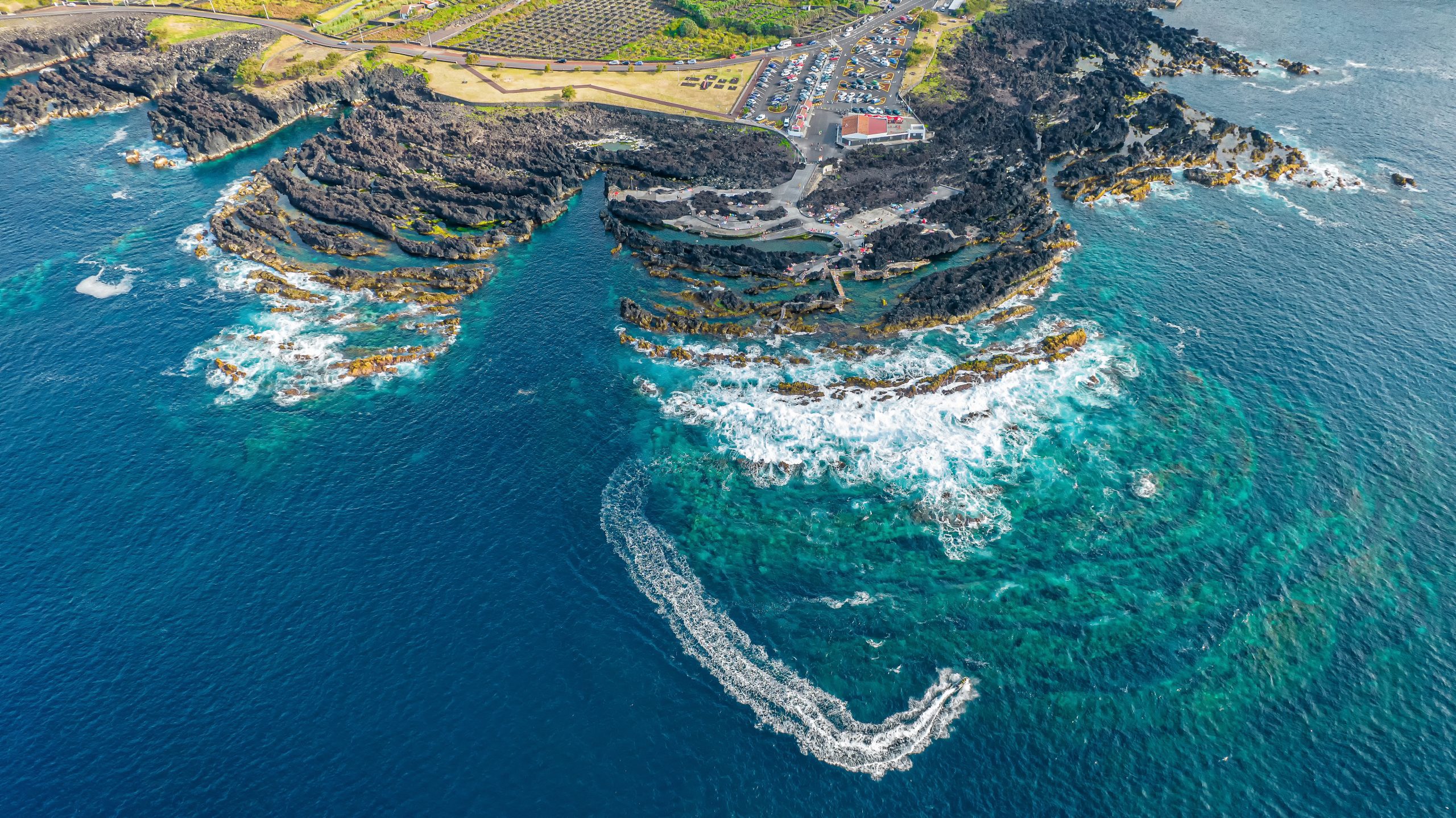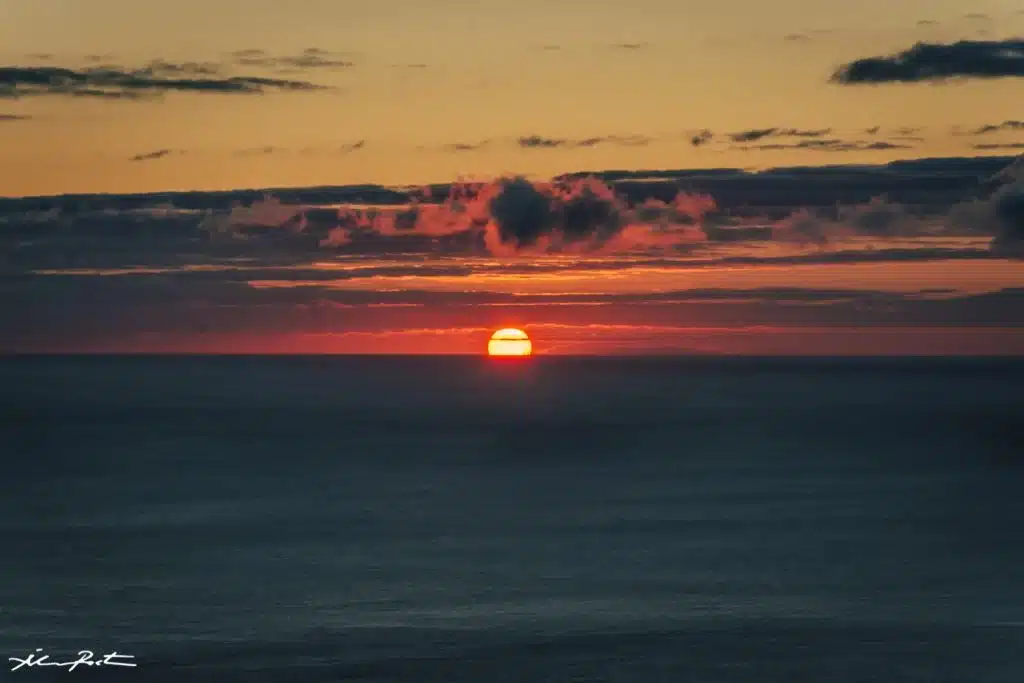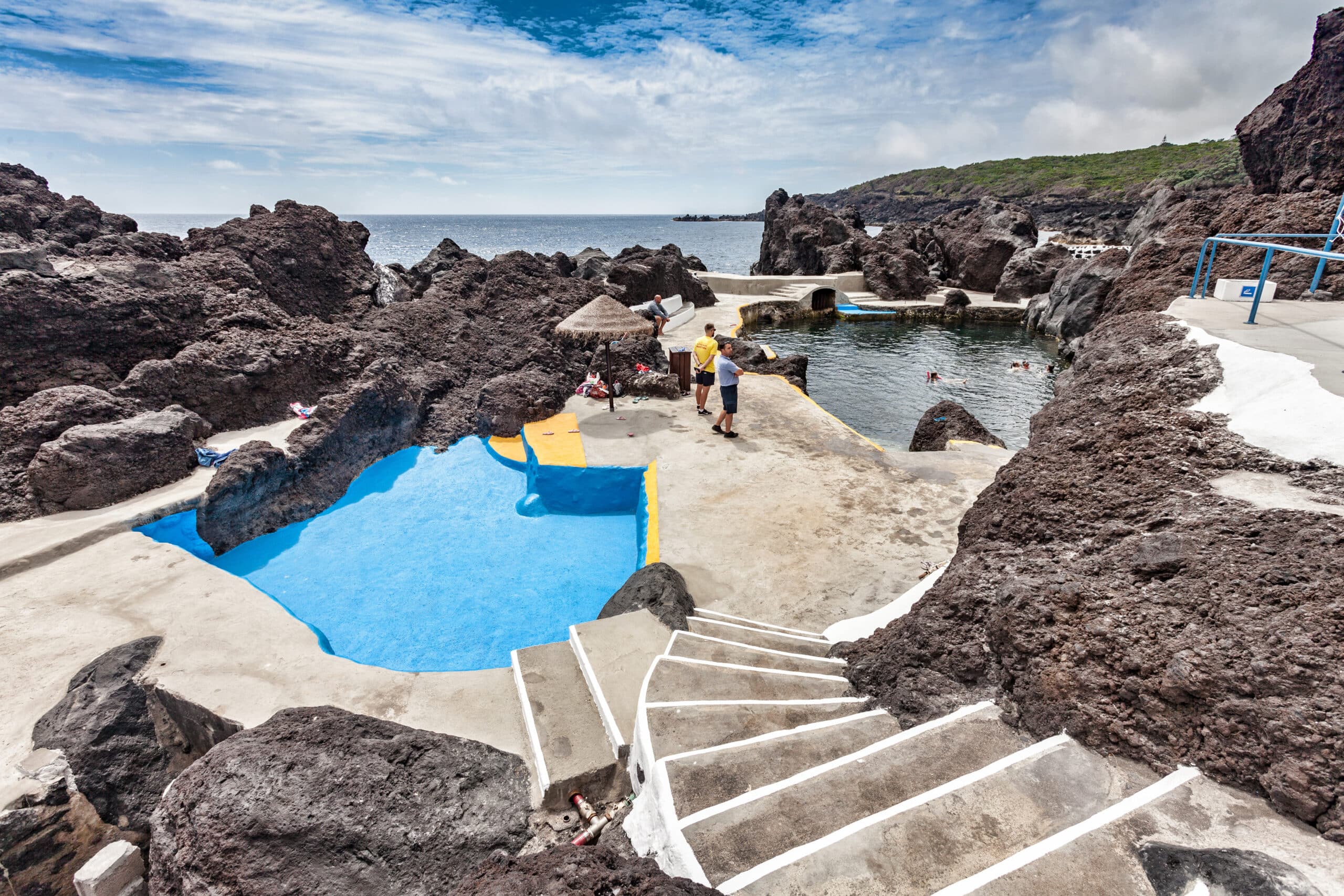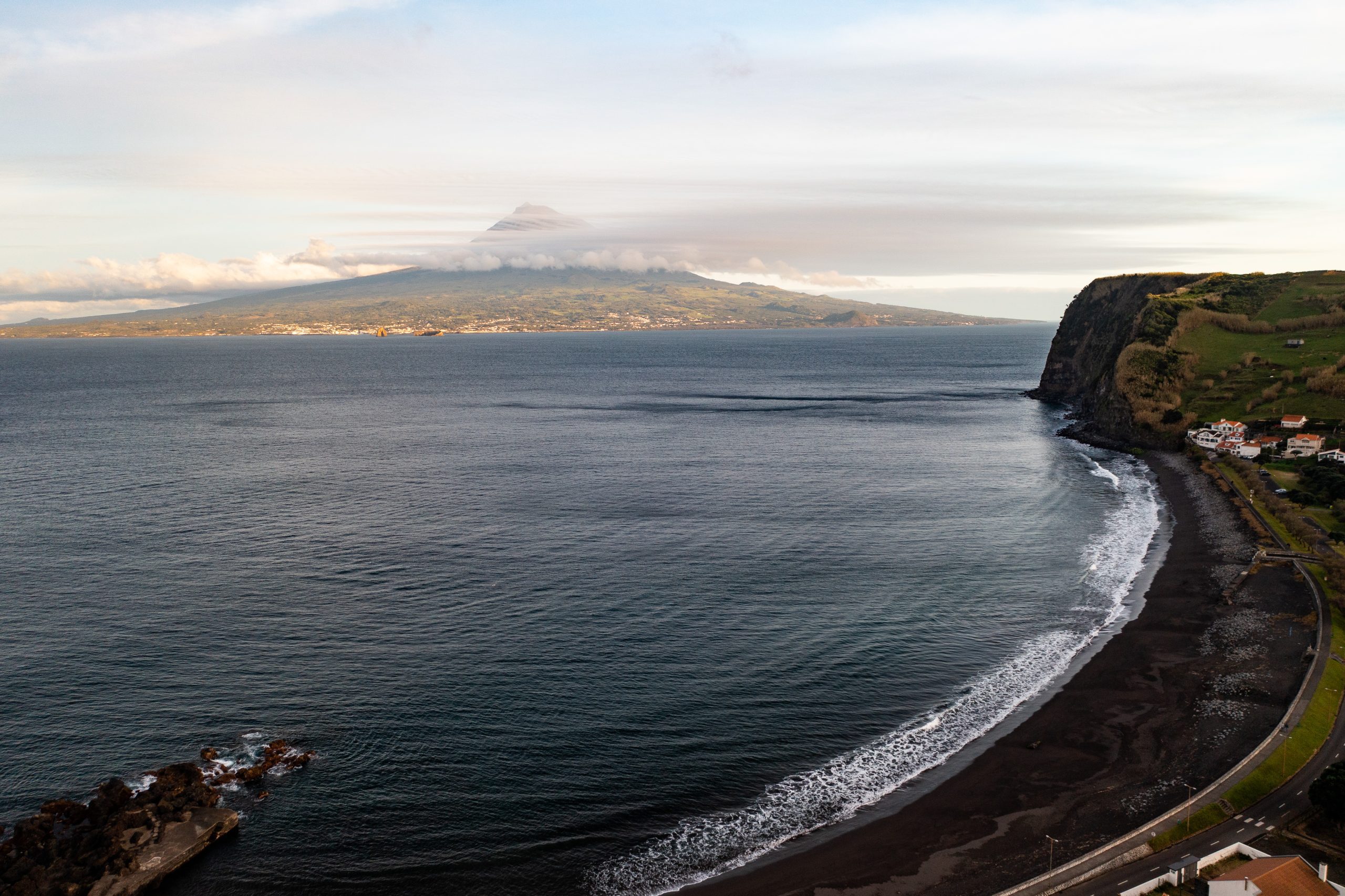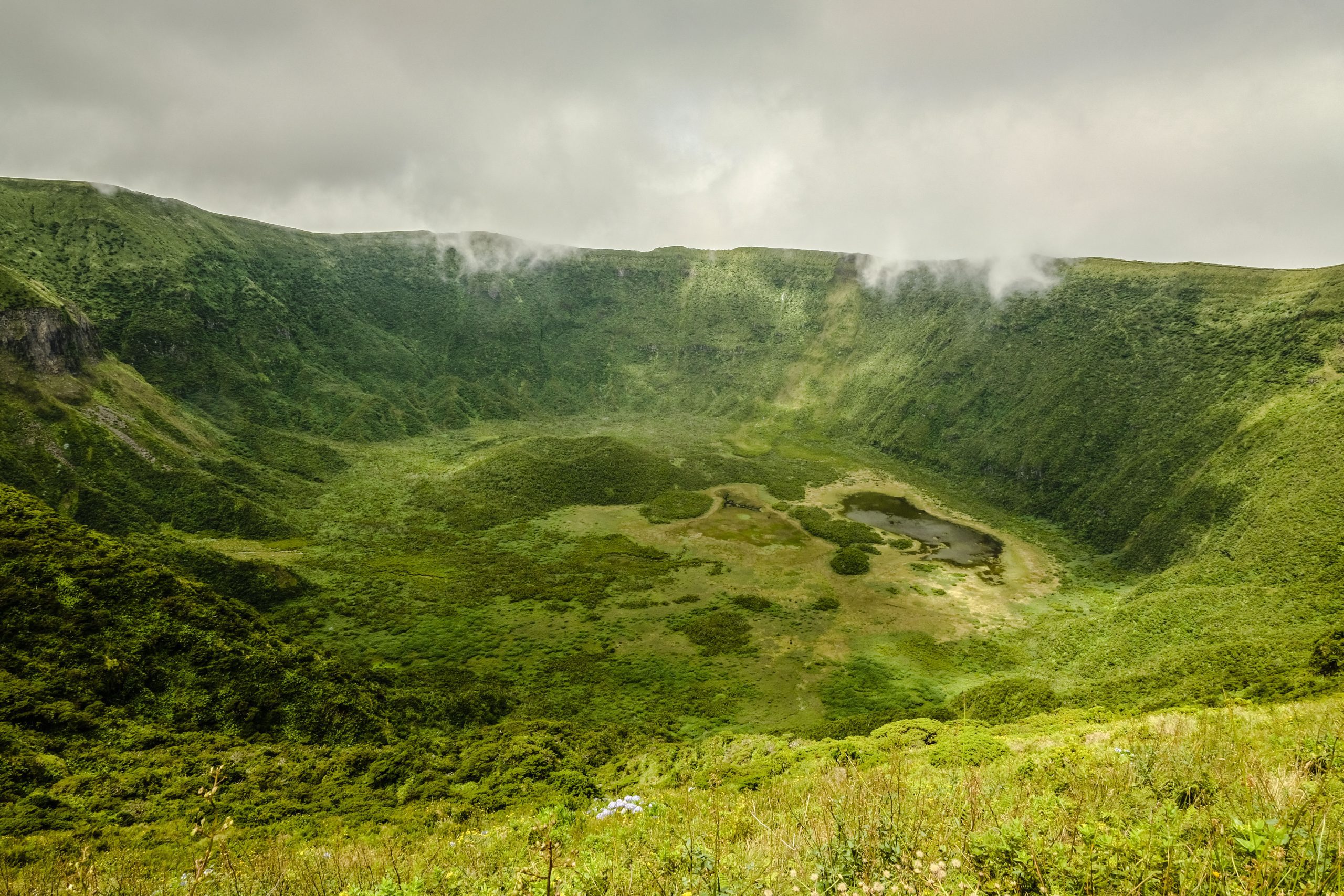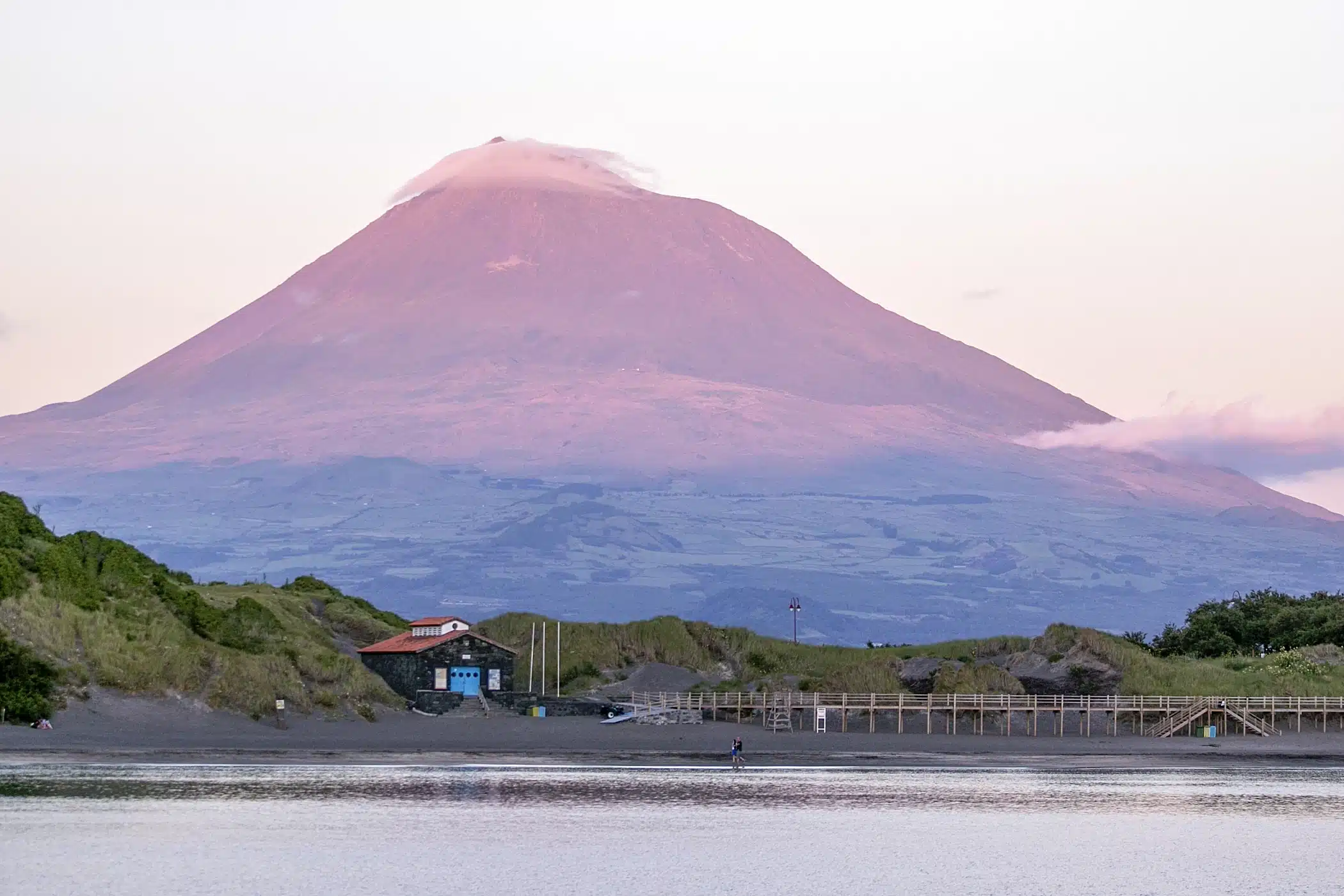Many consider the Capelinhos Volcano to be the region’s mystery of vulcanology. The Peninsula do Capelo, located approximately 300 meters from Ponta dos Capelinhos in Faial, sits in the middle of the Atlantic Ocean. It emerged from mixed volcanic eruptions, with both effusive and explosive periods.
Located in the Capelo Volcanic Complex, Capelinhos Volcano was the last to record an eruption in the Azores archipelago. Its consequences are visible today, including an increase in the territorial area of about 2.50 km², resulting from the solidification of lava above sea level.
After the eruption, the landscape developed a characteristic aridity and black tones from the volcanic ashes, contrasting with the typical lush green meadows of the Azores.
What is Capelinhos Volcano

Capelinhos Volcano, also known as the Mystery of Capelinhos, lies at Ponta dos Capelinhos in the parish of Capelo on the island of Faial in the Azores. Known for its striking beauty, it has become one of the region’s most popular tourist attractions.
The volcano forms part of the Capelo Volcanic Complex and follows a Volcano-Tectonic alignment with a general WNW-ESE direction. It consists of around 20 volcanic cones, which contribute to its unique landscape. The nearby islets, called ‘Ilhéus dos Capelinhos,’ are located just off the coast, in front of the iconic Capelinhos Lighthouse.
The volcanic activity that gave rise to the current landscape lasted thirteen months, with multiple eruptions between September 27, 1957, and October 24, 1958.
What to Do at Capelinhos Volcano
Follow the Whale Trail
The Whale Path highlights the importance of the former Whaling Port of Comprido — the Azores’ largest and most productive whaling station until September 1957. Here, you can contemplate what one of the most economically significant resources was for Faial during the whaling era.
Throughout the circuit, in addition to the Whaling Port of Comprido, you will have the opportunity to pass through various points of interest in the region, such as:
- Casa dos Botes: In the past, this was one of the favorite places for whalers to gather for meals or socialize in their leisure time. Currently, inside, you will find a permanent exhibition about whale hunting in the Azores.
- Costado da Nau: Here, in this hut’s remains, the locals began to see the volcano’s first volcanic manifestations — 12 days before its eruption.
The trail starts and ends in the Capelinhos Volcano Interpretation Center (CIVC) car park. You can complete this 3.8 km-long trail in about 1 hour and 30 minutes.
Explore the Interpretive Center of Capelinhos Volcano (CIVC)

Opened in August 2008, the Capelinhos Volcano Interpretive Center (CIVC) transports visitors back to September 27, 1957, a pivotal date in vulcanology history marking the eruption of Capelinhos Volcano in the Atlantic Ocean.
The center offers an informative, educational, and scientific experience through exhibits that explore eruptions and their impact on global volcanology. The CIVC also showcases a permanent exhibition dedicated to the history, cultural significance, and architectural diversity of Azorean lighthouses. Additionally, a temporary exhibition presents a remarkable collection of rock and mineral samples.
Recognizing its exceptional educational value, the European Museum Forum nominated the CIVC for the prestigious Best Museum in Europe award in 2012.
Contemplate the Panoramic View of the Capelinhos Lighthouse

The Capelinhos Lighthouse, built in the early 20th century, is a historical monument in the region. After its completion, the site became a significant landmark at Ponta dos Capelinhos.
In addition to the alternating red and white light that illuminated the area, this lighthouse was the only one in the archipelago to emit audible signals. In September 1957, a volcanic eruption rendered the Capelinhos Lighthouse inoperable. The disaster left the site in ruins, and part of its structure became buried.
If you want to visit the Capelinhos Lighthouse, you can do so by buying a ticket for 10 euros (free entry for all residents of Região Autónoma dos Açores). Note that you’ll have to climb many steps to reach the top of the 35-meter-high tower. However, the panoramic viewpoint rewards visitors with a magnificent view.
Please note that walking on the volcano itself is currently impossible. Visitors can only observe the site from the nearby lighthouse or the surrounding cliffs.
Explore the Caldeira of Faial

Many consider the Caldeira do Faial, located in the central part of the island, to be the flagship of Faial. It is one of the few places where it is still possible to imagine what the Azores were like before the archipelago was settled.
The Caldeira do Faial is a perfectly circular crater with an inner diameter of approximately 2 km and a depth of 400 m. It sits within the crater of the Central Volcano of the Caldeira. The current shape of the crater resulted from a collapse triggered by the last eruption of the Central Volcano, which occurred around 1,000 years ago.
Authorities designated this site as a natural reserve, and its lush Laurissilva vegetation plays a crucial role in preserving the Azores’ endemic habitats.
Plan your Visit to Capelinhos Volcano

Due to its mysterious origin, Capelinhos Volcano is one of the main points of interest for national and international tourists visiting Faial in the Azores. Therefore, before embarking on the adventure, you should plan your trip well.
After determining the dates and duration of your trip, choose the ideal accommodation based on your preferences and budget. The earlier you book, the more likely you are to find good deals at budget-friendly prices.
Additionally, you should plan an itinerary with all the places you want to visit and all the activities and experiences you would like to have during your stay in Faial.
Best Time to Visit
The ideal time to visit Capelinhos Volcano is between May and September, when the weather is typically clearer. This period allows you to enjoy peaceful walks through the mountains and volcanoes, with the best visibility at the viewpoints, especially when cloud cover is minimal.
Check all our articles about the weather in the Azores throughout the year 🌤️ ☔️: January | February | March | April | May | June | July | August | September | October | November | December
Best Time of Day
Experts recommend starting your visit early in the morning to explore Capelinhos Volcano and its surroundings thoroughly. Beginning your adventure at sunrise lets you make the most of natural light and enjoy the stunning scenery of the volcano and the island of Faial in a tranquil setting.
Where to Eat
If you need somewhere to eat near Capelinhos Volcano, click here. This link will take you to the 10 best restaurants on TripAdvisor.
Where to Stay
To make your life easier, we’ve filtered the search by:
How to Get to Capelinhos Volcano
To visit Capelinhos Volcano, you first need to reach Faial Island, which you can access by plane or ferry. Once on Faial, you have two main options for visiting the volcano: exploring independently by renting a car or joining a guided tour.
A guided tour offers the advantage of expert insights, as a local guide will share the history and interesting facts about the site. Whether you drive yourself or take a guided tour, visiting Capelinhos Volcano will be a memorable experience.
Planning a trip to the Azores? These articles will help you: How to Get to the Azores 🗺️ | Azores airports 🛬 | Flights between islands ✈️ | Ferries between islands ⛴️ | Which island to choose? 🏝️ | What airlines fly to the Azores? 🛩️
What to Bring
Have you planned your visit to Capelinhos Volcano? It’s time to discover the essential items that should never be missing to make your experience the best possible. We recommend bringing comfortable clothing, comfortable and suitable footwear, and a walking stick.
Additionally, don’t forget to bring a backpack with:
- Extra warm clothing;
- Waterproof or windproof jacket;
- Camera to immortalize moments;
- Sunscreen;
- Some snacks and water.
Azores Guide Book
Azorean Language & Phrases 🗣️ | Currency & Banks 💵 | Credit Cards & Traveler’s Cheques 🏧 | Driving in the Azores 🚗 | Electricity 🔌 | Experiences & Tours 🗺️ | Health & Safety 🩺 | Internet & Wi-Fi Access 🛜 | Phones & Mobile Service 📞 | Post Offices & Buying Stamps ✉️ | Public Holidays 🏖️ | Shopping 🛒 | Time & Daylight 🕒 | Whale Watching Guide 🐳 | Best Island to Visit 🏞️
Nearby Attractions
Horta

Horta, located on the island of Faial, is one of the most iconic destinations in the Azores and a must-see during your trip. People know the city for its bustling seaport, where they can watch the steady flow of boats and admire the sailboats moored in the marina. It attracts visitors worldwide, making it one of the Azores’ most famous cities.
This charming Azorean city offers a glimpse into its people’s unique culture and traditions. Numerous historical buildings and landmarks reflect the region’s rich history. Whether strolling through the streets or enjoying the scenic views, Horta provides an authentic experience of Azorean life.
Scrimshaw Museum

The Scrimshaw Museum of Peter, founded in 1986, is a must-visit during your time in Faial. Located on the first floor of the iconic Peter Café Sport building, this small yet fascinating museum showcases works by local artisans. The works, primarily made from sperm whale teeth and bones, celebrate the history of whaling in the islands of Faial and Pico through the art of scrimshaw.
The museum features a rich collection of utilitarian and decorative artifacts, with notable works by artists such as Fátima Madruga, Frank Barcelos, José Eduardo Silva, Camilo Costa, Manuel Gonçalves, Francisco Barreto, and José Barreto. The collection includes pieces by Jacob Tomás, João Flores, and Gualter Barreto.
Visitors can explore the museum Monday through Saturday, with an entrance fee of €3.50 per person. During the winter, the museum is open from 10 a.m. to 6 p.m.; in summer, it operates from 10 a.m. to 5:30 p.m.
What is Scrimshaw?
Scrimshaw is the art of carving, engraving, or painting on ivory, typically using teeth and bones from sperm whales. This craft originated aboard whaling ships, where it served to pass the time. Over time, scrimshaw evolved into both decorative and functional pieces. With the rise of whaling, sperm whale ivory became a sought-after material for creating utilitarian and decorative items.
Nossa Senhora da Conceição Viewpoint

Nossa Senhora da Conceição Viewpoint is located in Ponte da Espalamaca, north of Horta. After climbing the coastal road, you will find this beautiful location at the top.
From this viewpoint, you will find an image approximately 3 meters high in honor of Nossa Senhora da Conceição next to a cross over 28 meters high. From this location, you can contemplate spectacular views of the city and bay of Horta and Almoxarife Beach.
Caldeirinhas at Monte da Guia

The Caldeirinhas, or “Caldeira do Inferno” (Hell’s Cauldron), are twin volcanic craters at Monte da Guia. The sea partially submerges these unique geological formations, offering breathtaking Porto Pim Bay and Horta.
A submarine volcanic eruption shaped Monte da Guia. Today, the Caldeirinhas provide essential habitat for marine species like Salemas and Red Wrasse. In addition to their role in marine life, the area is rich in endemic Azorean flora, including heather and Faia-da-Terra.
The Caldeirinhas are part of a 10-hectare natural reserve that is valued for its biodiversity and scenic beauty.
Ten Volcanoes Hiking Trail
The Trail of the Ten Volcanoes (PR06 FAI) offers a challenging and rewarding hiking experience for nature lovers in Faial. Spanning 19.3 km, this linear trail challenges hikers, so they must prepare physically to tackle it.
Starting at the caldera area and descending towards the Capelinhos Volcano, the hike presents stunning volcanic landscapes and unique geological features. Due to the trail’s difficulty, it’s advisable to dedicate an entire day to fully appreciating the route. It’s crucial to check the weather conditions before embarking on this adventure to ensure a safe and enjoyable experience.
Natural Pools of Varadouro

Varadouro is a charming coastal resort that was once a favored summer retreat for wealthy families in Horta. Although still known for its natural pools, it has also evolved into a residential area.
The Natural Pools of Varadouro, located in Fajã do Varadouro in the parish of Capelo, offer a perfect spot for relaxation on warm summer days. Surrounded by stunning scenery, these pools provide a unique, serene experience for visitors of all ages.
Quick Info
Choose between the enclosed pools, ideal for children, or the open sea for a more adventurous dip. Whether you prefer the calm of the sheltered pools or the invigorating open ocean, Varadouro promises a memorable experience for everyone.
Check all our articles about each one of the most relevant points of interest on Faial Island: Caldeira do Faial | Porto Pim | Capelinhos Volcano | Praia do Almoxarife | Piscinas Naturais do Varadouro
Complementary Information
Best Season to Visit the Azores
The Azores Archipelago boasts a unique climate that shapes its lush landscapes, making it a splendid year-round destination. With mild temperatures and minimal fluctuations, each season offers something unique. Spring averages 16 °C, summer reaches 21 °C, autumn cools to 18 °C, and winter remains mild at 14 °C.
→ For a detailed breakdown of the weather by month, check the following links 🌤️☔️: January | February | March | April | May | June | July | August | September | October | November | December
How to Get to the Azores
The Azorean Archipelago is easily accessible through numerous flight routes. Lisbon and Porto are the main entry points to the continent, with direct flights available to São Miguel (PDL), Terceira (TER), Faial (HOR), Pico (PIX), and Santa Maria (SMA). To find the best flight, use search engines like eDreams or Skyscanner. These platforms let you compare prices and schedules from multiple airlines in one convenient location.
For more details on how to get to the Azores, take a look at our complete guide. But what if you want to explore beyond your arrival island? We’ve got you covered!
- Azores airports 🛬
- Flights between islands ✈️
- Ferries between islands ⛴️
- Which island to choose? 🏝️
- What airlines fly to the Azores? 🛩️
→ Once you’ve found the perfect route, book your tickets and get ready to experience one of the world’s most stunning island groups!
Travel Essentials
Essential Information for your Azores trip: Azorean Language & Phrases 🗣️ | Currency & Banks 💵 | Credit Cards & Traveler’s Cheques 🏧 | Driving in the Azores 🚗 | Electricity 🔌 | Experiences & Tours 🗺️ | Health & Safety 🩺 | Internet & Wi-Fi Access 🛜 | Phones & Mobile Service 📞 | Post Offices & Buying Stamps ✉️ | Public Holidays 🏖️ | Shopping 🛒 | Time & Daylight 🕒 | Whale Watching Guide 🐳 | Best Island to Visit 🏞️
Useful Tools & Apps
The weather in the Azores can be variable, so it’s helpful to use some apps before visiting the islands. Spotazores provides live camera feeds from the main tourist attractions, allowing you to check the weather and plan your visit. For accurate weather predictions, use Windy or Windguru — they provide the most reliable predictions.
Video
Conclusion
The Capelinhos Volcano on Faial is an exceptional destination, known for its volcanic origin and striking natural beauty. Rich in history and culture, it offers visitors a unique blend of scenic landscapes and captivating geological features. Surrounded by other picturesque spots, the area provides the perfect setting for unforgettable moments during your stay.
A visit to Faial reveals the raw power of nature, making it one of the most compelling islands in the Azores to experience its geological and natural forces firsthand.
Authors’ Note
I am pleased to inform you that all the recommendations in this article are based on my personal experience and observations. As the author, I have personally visited each attraction mentioned, ensuring that every suggestion is grounded in first-hand knowledge and genuine enthusiasm.
FAQs
The Peninsula do Capelo in Faial, Azores, hosts Capelinhos Volcano. It lies around 300 meters from Ponta dos Capelinhos, emerging from a mix of explosive and effusive volcanic eruptions that have shaped the region.
A submarine volcanic event caused the eruption of Capelinhos in 1957–58. The volcano’s eruption included explosive and effusive phases, drastically changing the landscape and increasing the island’s territory by 2.5 km².
The best time to visit Capelinhos Volcano is during the spring and summer when the weather is milder. Early mornings offer clearer views of the volcano’s dramatic landscape.
Visitors can explore the Capelinhos Volcano Interpretive Center, enjoy panoramic views from the nearby lighthouse, hike the surrounding trails, and admire the stark volcanic landscape that contrasts with Faial’s lush greenery.



